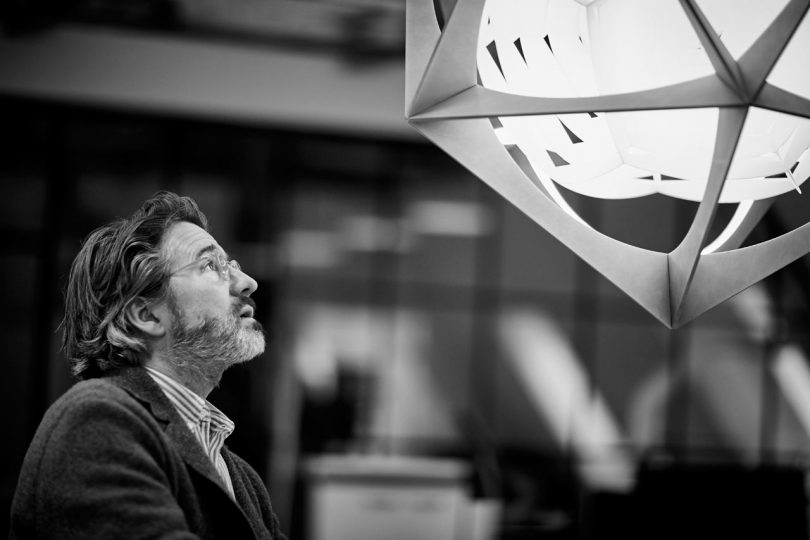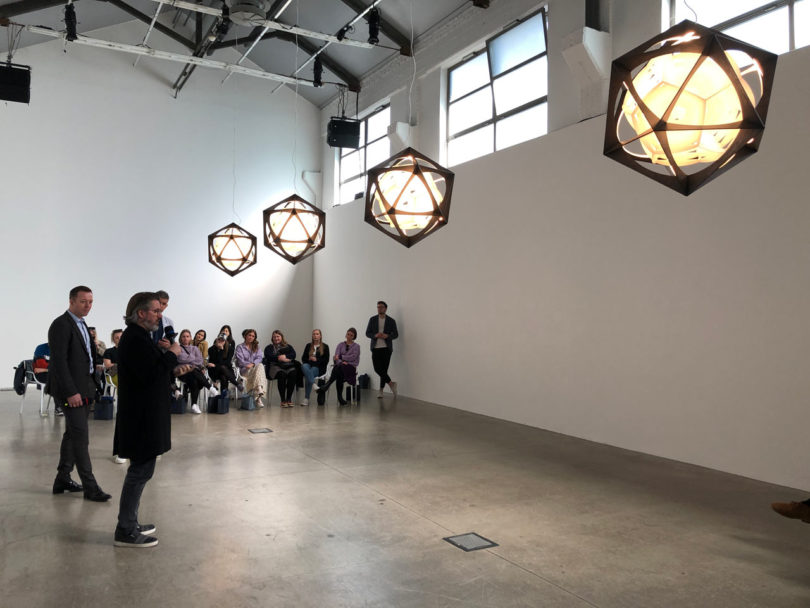Michael Yarinsky is an architect and interior designer practicing in Brooklyn. He specializes in commercial, residential, retail and hospitality spaces for and in collaboration with a community of designers and artists. Aside from practice, Michael is the founder/curator for Cooler Gallery outside the Brooklyn Navy Yard, runs Design Field Trip with Ladies and Gentlemen Studio, and is a contributing writer for Design Milk.
Olafur Eliasson is an internationally renowned artist typically known for his great installations, painting, and sculptures. Very new for him is a foray into lighting design – but Eliasson found a great match in Louis Poulsen. The company has always been dedicated to creating lights that are harmonious within their surroundings and have a positive effect on the viewer. Core to Eliasson’s practice is the power to affect people through lighting so together they worked on a conceptual lighting piece in an effort to question how good light can create a good life.
I had the incredible opportunity to sit down with Eliasson in Milan and have a deep and wide ranging conversation – How lighting can make invisible things visible, being aware of the pollution of a screen culture, how to create art within the structure of design, and lighting and the human psyche.
Let’s start with a big topic as an umbrella, I guess just start with the core of what I really wanted to discuss with you. That is – What have you learned through the course of your work to date about how to impact the human psyche through light?
With light we can make invisible things, visible. I guess that seems pretty obvious on the face of it but it is much deeper than that. With different light we can see things that we otherwise can’t see. I mean it in the way that different lighting can draw focus to different elements of a space – like with a strobe light, we can see still images in time, with monochromatic light, you can see black and white images. Also the more ambient the light or the more atmospheric, you can use it to bring awareness to something that appeared meaningless or unimportant or insignificant. In that sense, the atmospheric intensity of light holds the potential to make space both hospitable and spur critical thought. I think it’s quite interesting because if you can achieve that, you also can start bringing attention to our awareness of seeing itself.
My work is interested in how to actually see your own sensing, how to sense your own seeing – and that sense, it becomes a more introspective or subversive way of seeing where you are. The way I see you or what I see when I look at you is a construction created by all the things that I know about where we are today and what I know about you. This means I am not, by definition, seeing something real, but seeing the sum of information that I know. If I then bring the circumstances of the atmosphere to the right quality, I may be able to deconstruct this situation. By doing that, I might be able to see things about you that I might otherwise not be able to see. Often so, we mistakenly think that THIS is reality because we think our eyes are in fact (objective and neutral, given by nature, or some people even think they’re made by God) and in that sense, we don’t question whether what we see is right or real for that matter. And of course, one could even argue that everything is an illusion and nothing is real. We are sort of dreaming, right?
Indeed. I think people have been able to use this for both good and ill.
Yes, that of course has been used in successful, seductive consumerism to fulfill your desires and so on by being hyper-affirmative, and therefore there is also an equally strong tradition in culture to be skeptical of that, and to insist upon the necessity to allow people access to the tools with which they could deconstruct the consumerist machine. One could say my interest in light, or my interest in spatial practices with light, very often has been very much the idea of questioning the conditions under which, or through which, we see the world.
And I don’t think there is a “real” behind that when we’ve taken the veil of interests away, the veil of innocence, then you will see the truth. But there is no truth, behind the truth. It is very important to have the ability to navigate the fact that this is how we live, this is how we work, and this is how we do.
And in that sense, when I was invited by Louis Poulson, to talk first, and debate whether we could work together or not, I was quite interested to see whether I could bring about an artistic statement and take advantage of working with experts and learning. This lamp I could not have done myself – only with the expertise of the company. And then still see if I could make a statement. The machine is what you see first. When you look at the lamp you see through the machine and the light is on the inside. Normally, when you look in a lamp from here, the glow is on the outside and the machine, the bulb is on the inside. I wouldn’t call it atmospheric, but it’s more about design cohesion. It’s more about systems and relationships in that sense, the sophistication of design, in terms of understanding itself as a collective.
How would you say you could use light to mold space?
My interest in light came out of the idea of dematerialization. I was interested in making an empty room atmospheric. I was interested in the biology and the influence of light – almost like medicine – but also in terms of mental states. But also I became interested in how the movement of the light both changes hues, intensity and direction and so on. What we are seeing is the earth rotating around the sun, and rotating while it’s doing so. So I was very interested in the astronomic. If we were good enough at seeing, through the day, we could see roughly where on the planet we are, longitude and latitude. This is how sailors would organize their trajectory. The geometry in fact is inspired from an ancient Viking Sunstone used for navigation on the sea. A crystal with 2 different geodesic forms simultaneously that would polarize light in such a way as to be able to see the sun through the clouds. So the shape of the lamp actually comes from my broader interest in light. For me, I always, I was conscious of broader ideas while developing the lamp. Beauty has more to do with how and my interest was always more about why.
You spoke about this in the past, how both space and light are meant to be experienced in person. That light and space are both only truly experienced in person, and not meant to be shared through images. Can you speak a little bit to that?
We have a new light source that is becoming increasingly dominant – a screen based light source. There is quite a bit of light emitting from the screens we have, phones, tv’s, iPads and the quality of that light is surprisingly high. It is designed to output in a way that it keeps us more on the alert side of things. Our brains are tricked into thinking the images projected on us are real and we tend to not think of an emitted light.
Having said that, I do think that your question has more to do with us needing to learn to see light. We take it for granted that looking at a white wall in our apartment seeing the way the sun hits it is something that cannot be trained – but the truth is if you actually have the opportunity to spend time again and again, over a year, in a house or a flat or a room, you would eventually develop skilled sense of what you are seeing, should you pay attention to it.
And that in fact it is incredibly interesting, not just for poetic reasons, and simply in terms of looking at daylight bouncing off your domestic environment. As I understand, it can be relaxing and stress reductive, which I welcome. I think this can be associated with great pleasure and very high comfort, but this goes well beyond wellness and escapist visions. Fundamentally the issue is that we just need to understand that if we really pay attention, we can see things that are otherwise invisible – and that is a means of great joy.
Photos courtesy of Louis Poulsen, except where noted.
from WordPress https://connorrenwickblog.wordpress.com/2019/05/08/mdw19-a-sit-down-with-olafur-eliasson-at-milan-design-week/







No comments:
Post a Comment